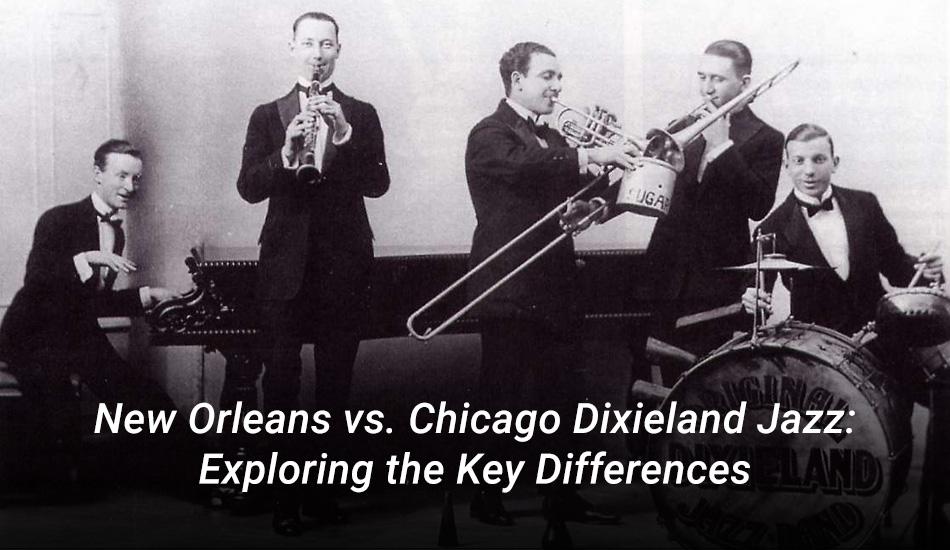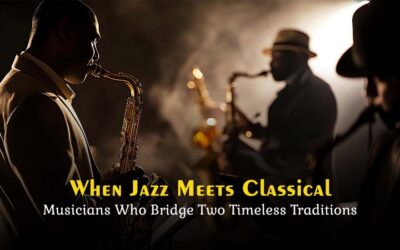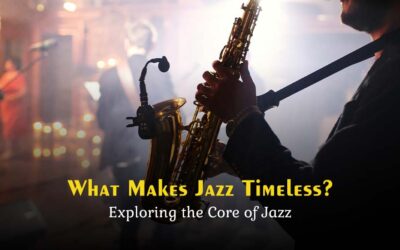Explore the two most influential jazz scenes with this insightful blog: New Orleans Vs. Chicago Dixieland Jazz. Starting with New Orleans, the birthplace of Dixieland Jazz, here is what makes it so unique. New Orleans Dixieland jazz is deeply rooted in African, Caribbean, and European musical traditions. You cannot resist tapping your feet to the beat when you listen to New Orleans Dixieland Jazz.
However, Chicago Dixieland Jazz, which emerged during the 1920s and 1930s, reflects the urban and industrial background of the city and is more polished and organized than its New Orleans counterpart. Dixieland jazz in Chicago is generally faster and more driving than jazz in New Orleans. With the bustling energy of the city and the influence of the Chicago swing era, women Jazz singers can take listeners on a whirlwind tour of these two influential jazz scenes with their captivating performances. There are many things in common between Chicago Dixieland Jazz and New Orleans Dixieland Jazz, but they are also distinct in specific ways, as follows:
Origins and Influences:
- New Orleans Dixieland Jazz: A range of cultures coexisted in New Orleans during the vibrant music scene that formed the foundations of New Orleans Dixieland Jazz. The musicians would come together and compose music, often seizing turns indicating off their skills and interacting with one another as well.
- Chicago Dixieland Jazz: The Chicago Dixieland Jazz, also known as Chicago-style jazz, occurred in Chicago during the early 20th century. Louis Armstrong is one of the significant figures in formulating Chicago Dixieland Jazz.
Instrumentals and Ensemble Style:
- New Orleans Dixieland Jazz: Traditional jazz is also known as New Orleans Dixieland Jazz; it is a joyful and infectious musical genre that emanated in the early 20th century. Trombones, trumpets, and clarinets generally form the front line of instruments in Dixieland Jazz. Each instrument adds a unique flavor to the music.
- Chicago Dixieland Jazz: The Dixieland Jazz ensemble consists of a trumpet, clarinet, trombone, piano, banjo, drums, and a double bass. These instruments combine to develop a lively and energetic sound interchangeable with the Chicago style. All instruments improvise in this technique, developing a lively and interactive musical conversation.
Rhythmic Approach:
- New Orleans Dixieland Jazz: New Orleans Dixieland Jazz is known for its rhythmic approach that is essential to its feeling. The singers’ collective improvisation endeavors the rhythmic technique. Polyrhythms play a main part in the rhythmic approach. The contagious rhythms of New Orleans Dixieland Jazz have influenced numerous artists and genres.
- Chicago Dixieland Jazz: The rhythmic approach in Chicago Dixieland Jazz analyzes the unique rhythmic components. Drummers create a vibrant rhythm by blending the snare drum, bass drum, and cymbals. Chicago Dixieland Jazz pianists use a different rhythmic technique called “stride piano.” Chicago Dixieland’s rhythmic foundation is made up of the brass section, which comprises trombones and trumpets.
Song Selection and Arrangements:
- New Orleans Dixieland Jazz: As part of any musical knowledge, song preference is a crucial part of the performance. Several conventional melodies are contained in this genre’s repertoire, containing “When the Saints Go Marching In ” and “Basin Street Blues’ ‘. To be successful, the arrangements of the chosen songs must be well thought-out.An essential characteristic of New Orleans Dixieland Jazz is “breaks” or “stop-time” sections. These spontaneous sections keep the music fresh and exciting. A New Orleans Dixieland Jazz arrangement is not fixed but serves as a framework for improvisation.
- Chicago Dixieland Jazz: As Chicago Dixieland Jazz fixes the mood of the performance, song selection is important. In Chicago Dixieland Jazz, the tempos and rhythms are usually lively and syncopated. A typical lineup consists of trumpets, clarinets, trombones, pianos, banjos, tubas, and drums. One exciting element of the Chicago Dixieland Jazz song selection is the inclusion of famous tunes from other genres. For example, you might listen to a Dixieland performance of a Broadway show tune or a well-known pop song, giving familiar melodies a new whirl.
Conclusion: A Tale of Two Cities and Their Jazz Legacies:
A genre that originated in the early 20th century, jazz has had a profound effect on cities around the globe. This blog explores the contrasting jazz inheritances of two iconic cities – New Orleans and New York City. Sylvia Brooks is the best jazz vocalist today who continues the jazz tradition. Duke Ellington, Count Basie, and Billie Holiday flourished in New York City during the Harlem Renaissance. Each city contributed to jazz differently, leaving an indelible mark.




